Publications

December 18, 2012
Using data from a phone survey of 1,980 Puget Sound residents conducted in 2012, this fact sheet describes public perceptions of different environmental interventions. Puget Sound residents widely support a range of proposed interventions designed to protect and restore the marine environment.
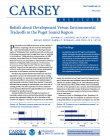
December 18, 2012
Using data from a phone survey of 1,980 Puget Sound residents conducted in 2012, this fact sheet outlines residents’ views about the importance of environmental protection as well as their opinions about energy development, protection of wild salmon, and land use regulation.
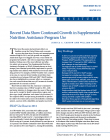
January 15, 2013
This brief uses data from the American Community Survey to examine rates of Supplemental Nutrition Assistance Program (SNAP) receipt in 2011, with particular attention to changes since the onset of the recession, and to receipt by family composition, region, and place type (rural, suburban, and central city locations).
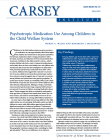
January 22, 2013
Prior research demonstrates that children in the child welfare system are given psychotropic medication at rates approximately three times higher than children and adolescents in the general population.
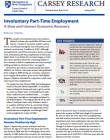
March 28, 2017
The number of involuntary part-time workers, defined as those who would like full time work but for a variety of economic reasons cannot find it, rose sharply during the Great Recession and reached a peak of over 9 million in 2010.1 Although unemployment overall has returned to its pre-recession level, involuntary part-time employment is still much higher than it was before the recession began, a…

April 4, 2017
America is growing more racially and ethnically diverse,1 yet some parts of the country are far more diverse than others. Migration—the flow of people from one place to another2—influences local diversity by continually redistributing the population3 and altering the racial mix in both the sending and receiving communities. Migration can serve an integrating function when people from different…

April 18, 2017
In 2015, for the second year in a row, child poverty rates declined in the United States. However, familiar patterns in levels and characteristics of child poverty persist: more than one in five children are poor; children of color are at disproportionate risk for poverty; and rates are highest in the South and West and in rural areas and cities (Table 1). This brief uses data from the American…
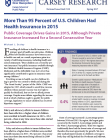
April 25, 2017
Enrolling all children in health insurance is a primary goal of health care advocates. Children who have health insurance have better access to health care and, as a result, experience gains in a variety of well-being measures, including health and school attainment.1 Most children are covered by private insurance,2 but public insurance available through the Children’s Health Insurance Program (…
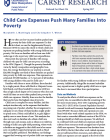
May 2, 2017
How often are low-income families pushed into poverty by their child care expenses? In this fact sheet, we use the Supplemental Poverty Measure (SPM) to assess the extent to which child care expenses are pushing families with young children into poverty. Nearly one-third (30.4 percent) of families with young children are poor. To fall under the SPM poverty line means that a family’s income would…

May 9, 2017
Every state in the United States with an income tax offers some kind of tax break to its older citizens. These breaks are often sizable, resulting in an elderly household owing substantially less in income taxes than a non-elderly household with the same income. In Alabama, Georgia, Hawaii, Illinois, Michigan, Mississippi, and Pennsylvania, married elderly households can have incomes well over $…
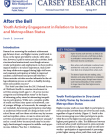
May 16, 2017
Research on narrowing the academic achievement gap between lower- and higher-income youth tends to focus on the inputs provided by schools. Little attention, however, is paid to extracurricular activities, both structured and unstructured, even though extracurricular participation and employment can have positive impacts similar to in-school experiences. Such activities keep adolescents engaged…
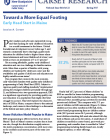
May 23, 2017
Policy makers and advocates nationwide recognize that funding for early childhood education is a crucial investment in the future. Critical foundational development occurs before age 5, and research consistently shows that high-quality early education for children leads to higher future educational attainment and lower likelihood of crime,1 and yields a return on investment of 7 to 13 percent.2…
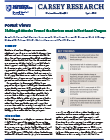
April 21, 2015
Residents of northeast Oregon were surveyed by telephone in an effort to assess individual perceptions of forests and natural resource management. Results show that residents are generally well informed about declining forest health, and they identify active forest management as a high priority. Just over half of residents support increasing public land use fees to pay for forest restoration…

May 19, 2015
In the several years since the Great Recession, New Hampshire, like the nation, has witnessed and experienced growing economic disadvantage. The state’s poverty level stands at 8.4 percent, and child poverty increased from about 8 percent in 2000 to nearly 10 percent in 2012.1 Some areas of the state have been hit harder than others. In the state’s largest city of Manchester, for instance,…

June 9, 2015
Recognizing that adequate health care is key to childhood development and long-term health, policy makers expanded public programs to provide children with health insurance: first, Medicaid in 1965 and, in 1997, the State Children’s Health Insurance Program (SCHIP). In April of 2015, Congress renewed SCHIP for two additional years. Therefore, providing children with health coverage has been…

June 16, 2015
The adverse effects of poverty on child and adolescent development are well documented and have been of interest to policy makers for several decades.1 Childhood poverty has a number of lasting impacts, including negative educational and cognitive outcomes, social and emotional behavior problems, poor adult economic outcomes, and health problems.2 For some children, these challenges are coupled…
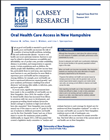
June 23, 2015
Just as good oral health is essential to good overall health, poor oral health can increase the risk of a number of serious health problems, including stroke and cardiovascular disease.1 Access to oral health care is not universal, however. Barriers to care may be related to dental insurance accessibility and affordability, out-of-pocket costs, provider availability, distance to providers, and…
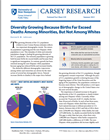
June 25, 2015
The growing diversity of the U.S. population evident in new Census Bureau estimates reflects two important demographic trends. The minority population is growing and the non-Hispanic white population is not. This interplay of white and minority population change is fueling the growing diversity of the U.S. population. The minority population is growing both because births far exceed deaths and…
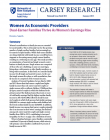
June 30, 2015
Women’s contributions to family income are essential for most families. This is obviously true for the growing number of single-mother families, but increasingly so for married couple families. While dual-earner families are doing relatively well, family income overall has been stagnant or decreasing among single-earner families, resulting in a widening income gap. This study provides an…
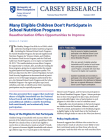
July 14, 2015
The Healthy, Hunger-Free Kids Act of 2010, which authorizes funding for federal nutrition programs (including the National School Lunch Program; the School Breakfast Program; the Special Supplemental Nutrition Program for Women, Infants, and Children; the Summer Food Service Program; and the Child and Adult Care Food Program), is set to expire on September 30, 2015.1 The reauthorization process…
